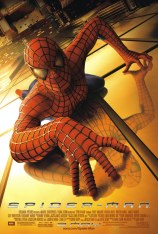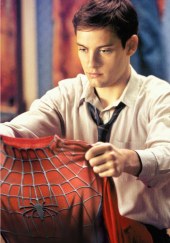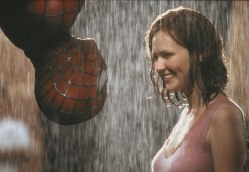|
Spider-Man
|
| |
 |
USA, 2002. Rated PG-13. 121 minutes.
Cast:
Tobey Maguire, Kirsten Dunst, Willem Dafoe, James Franco, Rosemary Harris,
Cliff Robertston, J.K. Simmons, Randy Poffo, Joe Mangianello, Jack Betts,
Gerry Becker, Bill Nunn
Writer: David Koepp, based on the Marvel Comic Book by Stan Lee
and Steve Ditko
Music: Danny Elfman
Cinematographer: Don Burgess
Producers: Ian Bryce, Laura Ziskin
Director: Sam Raimi
LINKS
|
Note: This review contains minor spoilers.
 s
the introductory credits and the Danny Elfman score (for once, out of place)
fade, a voice-over from Peter Parker (Tobey Maguire) establishes the motif of
the movie. "This is a story about a girl." The girl is Mary-Jane Watson, Peter's
next-door-neighbor and great unrequited love. It is through her evolving relationship
with Peter that his growth from boy to adolescent to man to citizen is measured.
s
the introductory credits and the Danny Elfman score (for once, out of place)
fade, a voice-over from Peter Parker (Tobey Maguire) establishes the motif of
the movie. "This is a story about a girl." The girl is Mary-Jane Watson, Peter's
next-door-neighbor and great unrequited love. It is through her evolving relationship
with Peter that his growth from boy to adolescent to man to citizen is measured.
By prioritizing the human aspect of the story over the expected biff-bang-pow,
director Sam Raimi (the Evil Dead series, A
Simple Plan, The Gift) lowered my expectations
of this summer blockbuster. As with the "classic" superhero tales (e.g., Batman,
Superman) the premise of this story is well known: Peter Parker, marginalized
in adolescence by his puny stature and myopic chess-club bookishness,, and living
an agonizing twenty yards from his true love, gets bitten by a genetically modified
spider.
Overnight, he ceases to be just a camera-toting voyeur, and is endowed with
20/20 vision, the ability to climb walls, and a sixth sense. The perfectly cast
Maguire conveys Peter's delight at his newfound abilities with a real twinkle
in his eye. He plays his increasingly profound understanding of his uncle's
advice ("with great power comes great responsibility") with more than just square-jawed
comic-book stoicism. The fact that Maguire is not endowed with a square jaw
lends credibility to the tenderness of the relationship between Peter and Mary
Jane.  These
characters speak (and listen) to each other, thanks in part to a script absent
of clumsy premise-establishing dialogue endemic to summer blockbusters. The
undoubted strength of the film Raimi has fashioned is the host of engaging interdependent
characters.
These
characters speak (and listen) to each other, thanks in part to a script absent
of clumsy premise-establishing dialogue endemic to summer blockbusters. The
undoubted strength of the film Raimi has fashioned is the host of engaging interdependent
characters.
Unlike Superman or Batman, who, when we first meet them in film, are essentially
au fait (if not wholly comfortable) with their superhuman sides, the
Spider-Man story is the chronological story of Peter's evolution. This gives
Raimi several opportunities to show his tongue-in-cheek side, most hilariously
in a series of not-too-subtle masturbation metaphor scenes involving Peter's
discovery that he can ejaculate webbing from a gland in his wrist. He spends
weeks practicing in his bedroom.
Superhero film convention demands a villain against whom the full mettle of
the superhero can be gauged. Right on time, the Green Goblin arrives. The subjugated
alter ego of Norman Osborn (Willem Dafoe), father to Peter's best friend Harry
(James Franco) and CEO of Oscorp, a chemical-weapon manufacturer, the Goblin
is born when Osborn impulsively decides to be the first human-guinea pig of
a new (but flawed) serum. Dafoe initially plays Osborn straight, but his performance
grows more campy as he seizes his opportunity to effect personally the success
of the experiment. The scene in which Osborn dramatically hurls the drained
vial of serum to the floor, tears off his shirt, and swishes over to the gurney
to be strapped-in, is priceless. "Ooh!" he exclaims, "it's cold."
Dafoe's face alone has enough intrinsic menace to suggest his alter ego will
be a nefarious nemesis to Spider-Man, but his Norman Osborn is insufficiently
imbued with pathos to generate much sympathy for his dilemma. Had the character
been fleshed out to a greater degree before his transformation, the impact would
have provided a counterweight to Peter Parker's equally dramatic transformation.
The changes he undergoes after taking the serum don't quite oscillate convincingly
between the good/evil dichotomy that this particular Jeckyll-and-Hyde villain
requires. What we do get is the highly unstable Green Goblin careering about
on a jet-propelled curved metal turbo-plank. This looks ridiculous, like a drunken
dad trying to impress his friends by riding his six-year-old's skateboard.
The action scenes are arguably the weakest part of the film. Not only is it
obvious when Spider-Man is computer-generated, but there is a static feel to
the larger-scale action scenes that (perhaps deliberately) resemble frames from
a comic book, even when Spider-Man is swinging from building to building. There
is little sense of Spider-Man as a human pendulum, no roller coaster-style disorientation
from these enormous swoops and falls. Better are the face-offs between Spider-Man
and the Green Goblin in closer confines, where there is effective use of Matrix-like
slow-motion projectile evasion. Clearly made by fans of the comic books, much
of the film is shot with the panache and bold stylistic form of the books themselves,
particularly the over-the-shoulder depth-of-field shots of many of the key interpersonal
scenes.  Raimi
uses this technique to particularly good effect in two key scenes in the film's
final moments (in Osborn's bedroom and in the cemetery), but also employs it
elsewhere during periods of less heightened tension to show the (often three-way)
exchanges between characters, reinforcing their interdependence.
Raimi
uses this technique to particularly good effect in two key scenes in the film's
final moments (in Osborn's bedroom and in the cemetery), but also employs it
elsewhere during periods of less heightened tension to show the (often three-way)
exchanges between characters, reinforcing their interdependence.
Elfman's score never intrudes on these intimate scenes. A good fit for gothic
stories (e.g., Batman, Sleepy Hollow),
the music works well here for the fleeting night shots of Osborn's Manhattan
penthouse and city vista. However, unlike the anonymous suburbia of Edward
Scissorhands, where Elfman's score reinforced the magical elements of Tim
Burton's vision, the daylight panoramas of the Queens suburbs where Peter lives
are less well served by Elfman's distinctive style.
The Green Goblin swoops and terrorizes the populace, and increasingly, Mary
Jane. Peter steps up to the plate, demonstrating that he can take care of his
personal agenda and his burgeoning civic responsibilities. They tussle
a couple of more times, with the Goblin attempting to bring Peter over to the
dark side of the Force… erm, sorry, to lure Peter into his green empire of evil.
By this point, however, Dafoe has spent so much time behind the Goblin mask
that he appears to have given up acting when not wearing it.
Although Raimi isn't afraid to end the movie on a vaguely melancholy note,
he does so in an unfinished-business kind of way. This ultimately makes the
film seem like an extended preview, priming us for the Spider-Man sequel
all along. This was especially apparent during the final minutes, during which
the dramatic undercurrent of the next installment is established with the romantic
triangle between Peter, MJ, and Harry as its crucible. Harry, who has been nursing
something of a troubled soul throughout, inherits both his Dad's fortune and
easily aggrieved temperament, and it's clear that he will play a major part
of the next film. The evenly paced development of his character gives him parity
with Peter and Mary Jane, and should make for a more balanced sequel. No doubt,
as Peter Parker doesn't quite get it together with Mary Jane, that movie will
again be about a girl.
Review
© June 2002 by AboutFilm.Com and the author.
Images © 2002 Columbia Pictures. All Rights Reserved.

 These
characters speak (and listen) to each other, thanks in part to a script absent
of clumsy premise-establishing dialogue endemic to summer blockbusters. The
undoubted strength of the film Raimi has fashioned is the host of engaging interdependent
characters.
These
characters speak (and listen) to each other, thanks in part to a script absent
of clumsy premise-establishing dialogue endemic to summer blockbusters. The
undoubted strength of the film Raimi has fashioned is the host of engaging interdependent
characters.
 Raimi
uses this technique to particularly good effect in two key scenes in the film's
final moments (in Osborn's bedroom and in the cemetery), but also employs it
elsewhere during periods of less heightened tension to show the (often three-way)
exchanges between characters, reinforcing their interdependence.
Raimi
uses this technique to particularly good effect in two key scenes in the film's
final moments (in Osborn's bedroom and in the cemetery), but also employs it
elsewhere during periods of less heightened tension to show the (often three-way)
exchanges between characters, reinforcing their interdependence.
